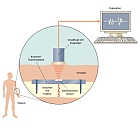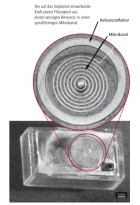Monitoring broken bones without using electronics
A wireless bone monitor

|
The novel sensor is intended one day to help doctors monitor broken bones as they grow back together. Depending on the values of the forces measured by the sensor, they can decide whether the healing process is progressing normally or whether there is a danger that the fracture or implants might be overloaded. Until now doctors have used expensive and complicated electronic devices which sent the measured data to the outside world as radio signals. On the other hand, according to Felix Gattiker of Empa’s Electronics, Metrology and Reliability Laboratory, an electronics-free sensor offers many advantages – not least of the financial kind. In the new Empa sensor the data is read out by means of an ultrasonic scanner. | |||
| The solution is in the form of a small, hollow spiral which sits on the implant together with a fluid reservoir. When the implant is subject to compression or tension the level of fluid in the spiral changes. This level is measured with the help of an ultrasonic device, and the resulting data allows the mechanical loading on the implant to be calculated. The ultrasonic image is, however, too indistinct to allow the fluid level to be determined visually, so the Empa researchers decided to analyze the ultrasonic signal in more detail. They quickly found a dependence between the ultrasonic echo generated over the complete spiral and the actual fill level – the weaker the ultrasonic echo measured, the higher the level, and therefore the greater the force acting on the sensor. | ||||
|
Further research is already in the pipeline The sensor produces reliable measurement data, as numerous experiments with artificial tissues – mixtures of gelling agent, glass ballotini and graphite powder, which depending on the mixing ratios allow different types of tissue to be simulated – have demonstrated. Not only that, it is also economic to manufacture, being very much cheaper than the existing electronic versions. The next step is to test the accuracy of the new method using various animal tissues, since each material has its own acoustic signature because it reflects and absorbs ultrasonic energy differently. |
|||
|
In addition, the Empa scientists are investigating the idea of making the sensor out of biodegradable materials, in which case the device would simply dissolve away in the patient’s body after completing its task. The surgeon need not therefore sharpen his scalpel a second time, there being no need to remove the sensor when the fracture has healed! And finally, there is the outstanding matter of finding an industrial partner to manufacture the sensors and integrate them into the implants.
|
||||
|
|||


